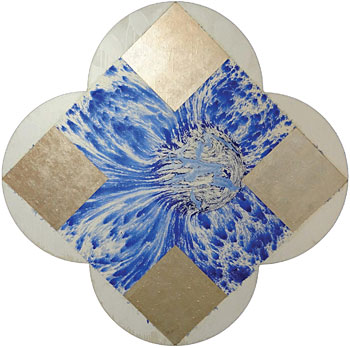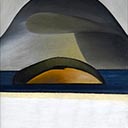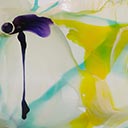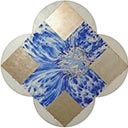Dionysus
152.5 x 152.5 cm
est. $65,000 - 75,000
 Relative size
Relative size
PROVENANCE:
Private Collection, Wellington Purchased from Page Blackie Gallery, 2005
ILLUSTRATED:
p. 74 Max Gimblett, Wynstan Curnow, John Yau, Craig Potton Publishing in association with Gow Langsford Gallery 2002
How was a particular painting made? Do we really want to know? Of course we do. To explain how a painting was painted seems to solve a mystery,. penetrate a secret, establish a cause for the work's tantalising effects. Explanation puts anxious viewers on more equal terms with the work, so it won't lord it over them so much; it enables us to evade its unseemly advances. Take Dionysos, 1988/89, for example. Is that the form of a goat I see? Once we have the painting's secret, we are satisfied that this is all we need to know. But there may be no satisfactory answer as to how it was done. It is not that the artist won't explain, but rather that he can't. He wasn't watching, or if he was, there was nothing he could or would do. He had faith. So I am going to tell you that having blocked out the four square elements on the quatrefoil, Gimblett began to prance around the stretcher which lay with its back on the floor, dripping ultramarine, Pollock-fashion, into pearlescent whites that he had previously poured, pooled and panned on and across its surface. What a potent, not to say stupefying procedure it turned out to be, for the paint gave off a vapour you could see as well as smell. Was that a genie he saw taking shape in the ether? For the next five to six hours the painting keep changing, moving further and further away from any readable relation to acts of its making. The painter had decided to intervene as little as possible; he became a bystander. Or a bysitter, now and then gently coaxing it along with the insertion here and there underneath the stretcher of a small cardboard wedge. The embodiment of a wild blue purpose was about to absorb the white firmament of his quatrefoil. The more closely he followed the transmutations, the more he was gripped by his abandonment. Of the painting? Of himself? Where, then, is Dionysos? What has become of him? These queries are reminders of the growing number of Gimblett's paintings whose surfaces are not gesturally produced. 'Gestures' are already not only marks made by the brush, registering the tactile; to stretch their meaning to cover spillage, gilding and polishing is to suppress not only the action of the materials themselves, but the significance of the variety of agencies such extensions give rise to.
Text: p. 38-39 Max Gimblett, Wynstan Curnow, John Yau, Craig Potton Publishing in association with Gow Langsford Gallery 2002




